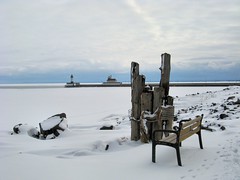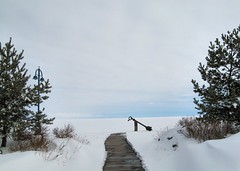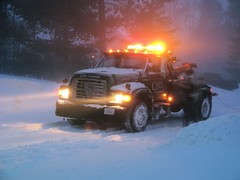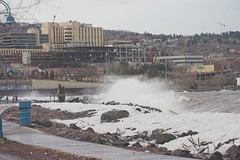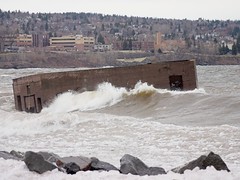Friday, October 19, 2007
Nor' Easters
Big Blows:
November 23, 1905:
The peak wind gust with this storm, measured by the Weather Bureau, was 70 mph. there were no mishaps on Lake Superior as most ships stayed in port.
Mataafa Storm, November 28, 1905:
This storm wrecked or disabled 18 ships, including the Mataafa. The Mataafa ran aground just outside the Duluth pier. Temperatures plummeted to -10 degrees F. Of the 24 men on board, fifteen were rescued after the waves abated. Four men froze to death and the last five were missing and presumed dead. The peak wind measured by the Duluth Weather Bureau was 68 mph. The wind gusted over 60 mph in Duluth for 15 consecutive hours.
The Great lakes Storm of November 7 1913:
This storm is historically referred to as the "Big Blow", the "Freshwater Fury" or the "White Hurricane". This was the deadliest and most destructive natural disaster to ever hit the Great Lakes. The storm killed over 250 people, destroyed 19 ships and stranded 19 others. The closest sinking to Duluth was south of Thunder Bay, where the Leafield went down killing all 18 crew members.
The Armistice Day Storm, November 11, 1940:
The day began fairly warm with temperatures in the 40's. As the day wore on rain turned to blinding snow. Ten death were blamed on the storm, with 66 sailors dead on Lake Michigan. Forty-nine peopled died in Minnesota, most of them duck hunters who set out in the morning unprepared.
The Edmund Fitzgerald Storm, November 10 1975:
This is the infamous storm that sank the Edmund Fitzgerald, which at the time was the largest of the lakers on the Great Lakes. The "Fitz" had just loaded taconite in Superior and was headed to Detroit. Most of her 26 crew members were from the Twin Ports of Duluth-Superior. All perished.
The Socrates Storm, November 18, 1985:
Strong winds of 69 mph and high waves beached the Greek ship the Socrates on Duluth's Park Point for six days.
Record Low Pressure, November 10, 1998:
This intense storm produced Duluth's lowest ever recorded barometric pressure of 28.475 inches or 964.3 millibars and produced gale force winds of 55 mph.
March Blizzard, March 1-2 2007:
This storm brought over 20 inches of snow and winds over 50 mph to the Duluth area, the north shore of Lake Superior and extreme northwestern Wisconsin. Fifteen foot snowdrifts covered Park Point
Posted by kgj at 10:30 AM 0 comments
Thursday, October 18, 2007
Autumn Nor'easter
October 2007
I woke from a light fitful sleep to the sound of rain and rain outside my slightly opened bedroom window. The clock showed 4 am. Lila would not expect a walk for another 45 minutes. Because of the rain and wind, I doubted that we would walk far.
A strong “nor'easter” is hitting the area today, packing heavy rain and wind gusts to 55 mph. ...
Because of the winds, the Weather Service has issued a gale warning that is in effect until 7 p.m., when a small craft advisory will take effect and last into late tonight. Today’s strong northeast winds will create waves of 10 to 14 feet on Lake Superior.
(http://www.duluthnewstribune.com/articles/rss.cfm?id=52461)
The spring and autumn equinox mean little here in Northeastern Minnesota. The gales of spring and Autumn mark the major changes of season.
I walk through the sky walk, periodically passing puddles, with buckets or yellow caution signs where wind helped force the rain gain entry. These winds sink ships and flatten the works of human kind. When we human kind have passed it will be the wind that will hand this landscape we have changed back to nature restored.
(Pictures from the Spring of 2005)
I woke from a light fitful sleep to the sound of rain and rain outside my slightly opened bedroom window. The clock showed 4 am. Lila would not expect a walk for another 45 minutes. Because of the rain and wind, I doubted that we would walk far.
A strong “nor'easter” is hitting the area today, packing heavy rain and wind gusts to 55 mph. ...
Because of the winds, the Weather Service has issued a gale warning that is in effect until 7 p.m., when a small craft advisory will take effect and last into late tonight. Today’s strong northeast winds will create waves of 10 to 14 feet on Lake Superior.
(http://www.duluthnewstribune.com/articles/rss.cfm?id=52461)
The spring and autumn equinox mean little here in Northeastern Minnesota. The gales of spring and Autumn mark the major changes of season.
I walk through the sky walk, periodically passing puddles, with buckets or yellow caution signs where wind helped force the rain gain entry. These winds sink ships and flatten the works of human kind. When we human kind have passed it will be the wind that will hand this landscape we have changed back to nature restored.
(Pictures from the Spring of 2005)
Posted by kgj at 2:31 PM 0 comments
Labels: "Lake Superior", gale, October, rain
Subscribe to:
Posts (Atom)
